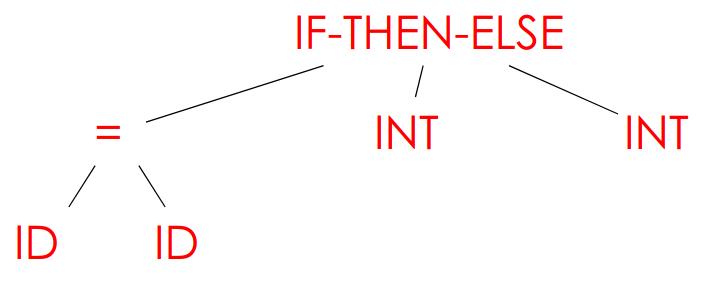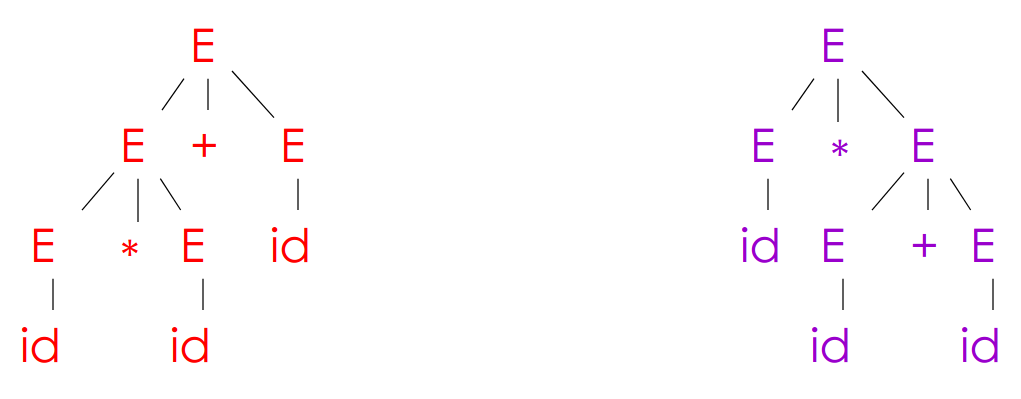Parsing #
Parser functionality #
- Input: sequence of tokens from lexer
- Output: parse tree of the program (in practice, Abstract Syntax Tree)
- Parser distinguishes between valid and invalid strings of tokens
- Requires a language for describing valid strings of tokens
- Requires a method for distinguishing between valid and invalid strings of tokens
e.g.
- COOL syntax:
if x = y then 1 else 2 fi - Parser input (Lexer output):
IF ID = ID THEN INT ELSE INT FI - Parser output:

Context-Free Grammars #
Disadvantages of regular languages:
- Many languages (i.e., balanced parenthesis) are nonregular yet we want to be able to capture them
- A finite automaton that runs long enough must repeat states, but finite automata can’t remember the number of times it visited a state
A CFG is a natural notation for recursive structure found in programming language constructs
- e.g. an
EXPRcan beif EXPR then EXPR else EXPR fiwhile EXPR loop EXPR pool
- A CFG consists of
- A set of terminals
T - A set of non-terminals
N - A start symbol
S(a non-terminal) - A set of productions X -> Y1Y2…Yn, where
- X in N
- Yi in T ∪ N ∪ {ε}
- A set of terminals
- COOL example:
EXPR -> if EXPR then EXPR else EXPR fi | while EXPR then EXPR pool | id - Implementation: Bison
CFG languages #
- Read productions as rules: X -> Y1Y2…Yn means X can be replaced by Y1Y2…Yn
- Key idea:
- Begin with a string consisting of the start symbol
S - Replace non-terminals $X$ in the string by the right-hand side of some production X -> Y1Y2…Yn
- Repeat (2) until there are no non-terminals left in the string
- Begin with a string consisting of the start symbol
- Formally: Let $G$ be a CFG with start symbol $S$. Then the language of $G$ is {a1…an | S ->* a1…an and every ai is a terminal}
- Terminals are so-called because there are no rules for replacing them: once generated, they are permanent
- Terminals should be tokens of the language
- Example: strings of balanced parantheses
- S -> (S), S -> ε
- Example: arithmetic expressions
- E -> E+E | E*E | (E) | id
Derivations and parse trees #
- A derivation is a sequence of productions leading to a string of only terminals: s -> … d -> …
- A derivation can be drawn as a tree
- Start symbol is a tree’s root
- For a production X -> Y1Y2…Yn add children X -> Y1Y2…Yn to node X
- Example:

- Notes:
- A parse tree has terminals at the leaves, non-terminals at the inner nodes
- An in-order traversal of the leaves is the original inputs
- The parse tree shows the association of operations, the input string does not
- Can do derivations in left-most order (replace left-most non-terminal at each step) or right-most order; these yield equivalent parse trees
Ambiguity #
- A CFG is ambiguous if it has more than one parse tree for some string
- Leaves meaning of some programs ill-defined
- Example:
- Grammar E -> E+E | E*E | (E) | id
- String id * id + id
- Yields following parse trees:

- To deal with ambiguity, most direct method is to rewrite grammar unambiguously
- E -> E’ + E | E'
- E -> id * E’ | id | (E) * E’ | (E)
- Enforces precedence of multiplication over addition
- Tools now can allow precedence and associativity declarations to allow one to write natural ambiguous grammar and then disambiguate later